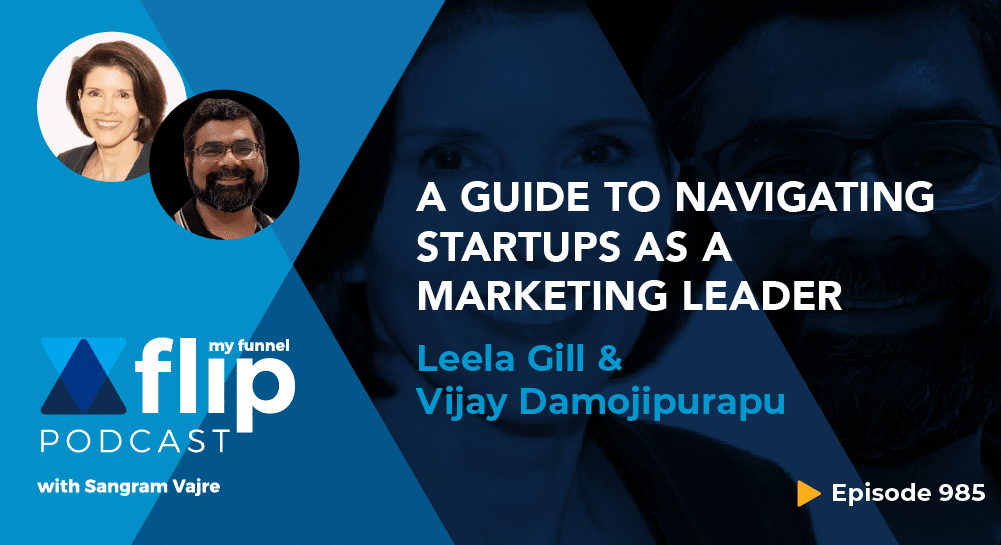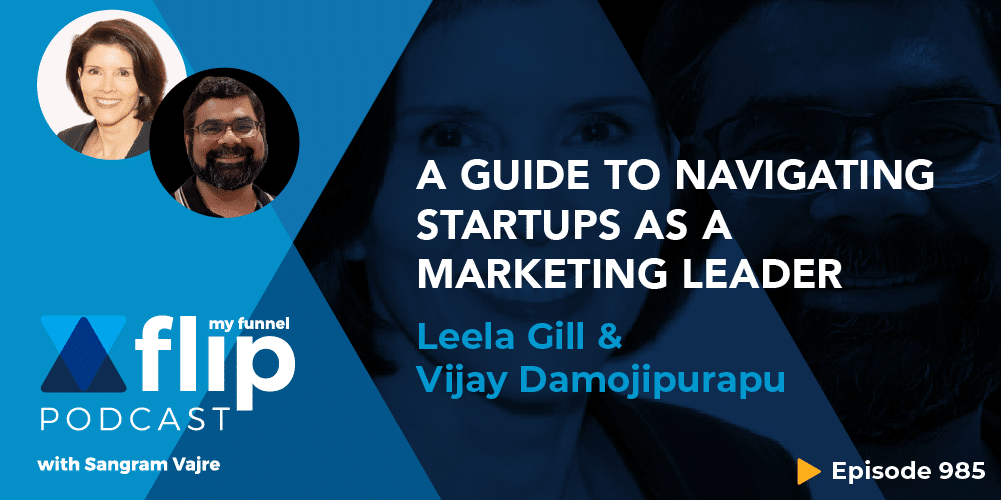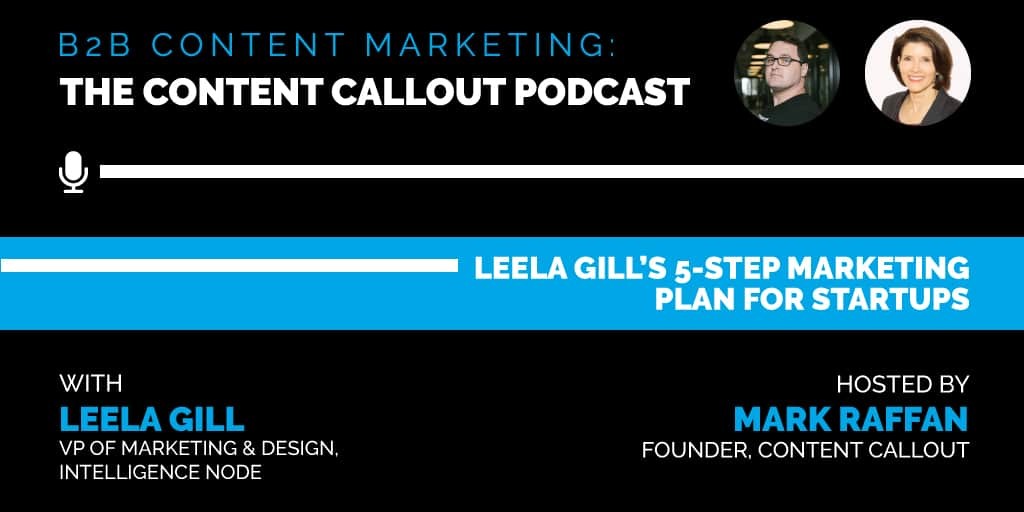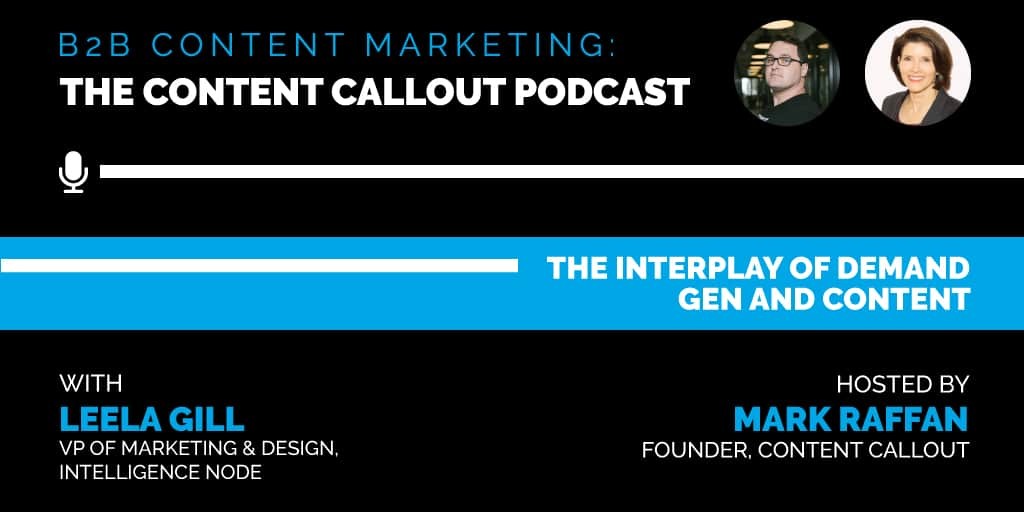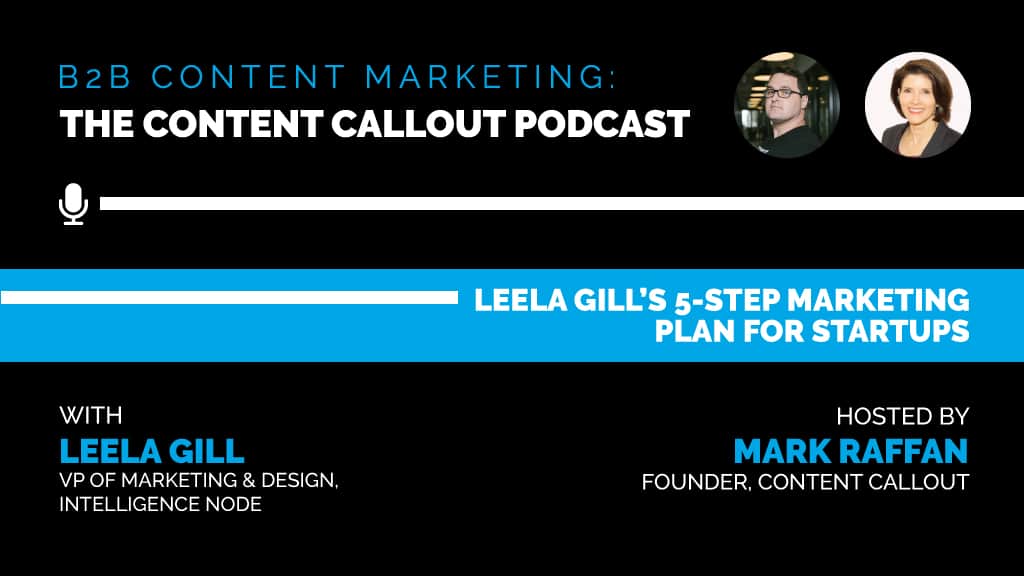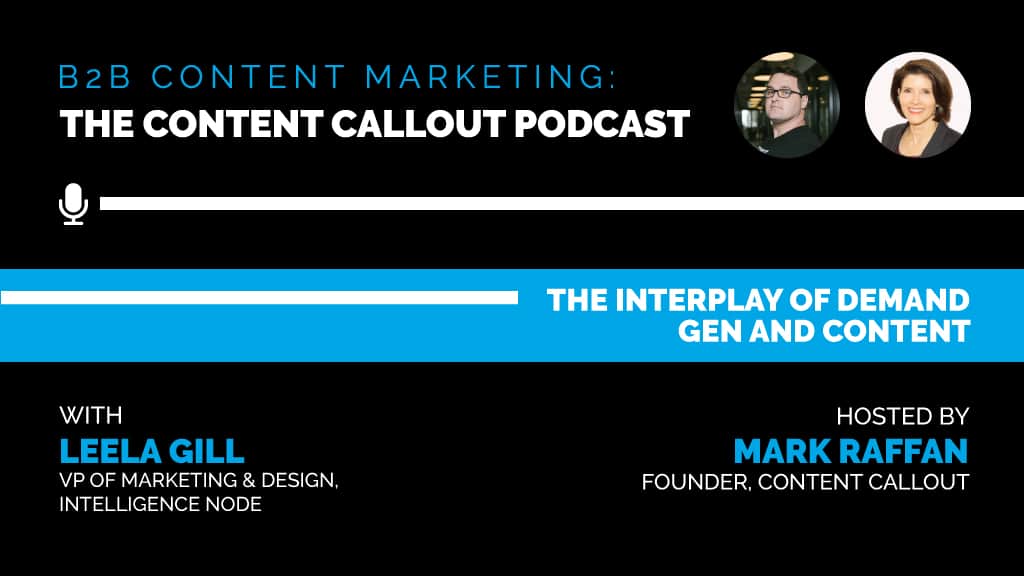A Guide To Navigating Startups as a Marketing Leader
It can’t be understated: Being a marketing leader of a startup can be crazy and chaotic. Out of the million tech startups formed every year, only 60% make it to series A, 20% make it to series B, and only 200 go IPO. The good news, however, is that once you make it, you have a strong chance of continued success.
Our guests today, Leela Gill, VP of Marketing & Design at Intelligence Node, and Vijay Damojipurapu, Founder and Principal at Stratyve, share two strategies to help grow your business and reinforce your position as a marketing leader.
Understanding what makes early stage company success so difficult
If you’re a leader in marketing trying to build a startup, it’s going to come with it’s fair share of hurdles; and with so little chance of success, it’s crucial to know the steps to take to be within the lucky few. For Leela, she connects the scenario to that of baby sea turtles making their way to the ocean — while the odds are stacked against them, the turtles that make it will live long and prosperous lives.
And to drive home just how important marketing is to the success of the business, a startup incubator in the San Francisco Bay area, called Wilbur Labs, recently surveyed over 150 founders. After collecting the results, they found that marketing ranked consistently higher than the product in regards to business success. If you’re looking to invest your time, make sure marketing is on the table.
Honing in on what specifically a marketer can do
Leela and Vijay recognize that investors will look at a few key factors when decisions are made: Leadership team skill, product power, market disruption, and how large the market is. While important, they’re looking to help enact change specifically as a marketer.
”We’re going to try to hone in on what you, specifically as a marketing leader, can do to help your company grow and thrive in this crazy competitive world of early stage business.” — Leela Gill
The operating framework
In the same way that we all know some of the more obvious ways to lose weight, like exercise and eating healthier food, the framework that Leela shares might have seemingly obvious, but often ignored, advice.
Time
Recognized as the first leg of the framework, this means to put together a formal quarterly cadence calendar that speaks to three different groups: The executive stakeholders, specific team members, and customers.
And, while there’s a high possibility that a similar setup is already in place, Leela warns that those meetings tend to focus on what to sell to the board rather than problem solving.
Money
Many startups don’t have the luxury of having millions or even one million to spend on marketing. Despite the desire to spend money on everything in the beginning, it’s important to invest in demand gen instead.
”When you have a limited budget, you have to really put the blinders on, focus, and make sure you’re executing that budget in a very prioritized way with respect to the pipeline.” — Leela Gill
Focus
This is more than just goal setting, it’s focusing on your exit criteria — what is going to help you survive as you transition to the next stage? If you get to series C, you’ll need to have documented processes in place.
The growth flywheel
Once you have the framework in place, where do you go from there? There has to be a way to push the boundaries to think and act differently. Vijay’s suggestion: You need an all-star CMO to pave the way for your team.
”Winning CMOS are consistent; they know it’s going to take a long time and they’re in it for the long haul.” — Vijay Damojipurapu
After interviewing several exceptional CMO’s, Vijay boiled down the insights:
- Content: The currency of a go-to-market machine. Used to earn credibility and trust.
“The content has to be unique, but it also has to be done on a consistent basis,” Vijay explains.
- Experiences: The CMO’s ability to create memorable events that focus on industry problems or speaking to the competitive ecosystem.
- Community: Sharing common pursuits and improving on a daily basis within the organization.
A key takeaway
Creating a successful tech startup can be a near impossible task. Arming yourself with the best strategies, like the operating framework paired with the growth flywheel, can give you the competitive edge that sets you apart from the crowd.
Related Posts:
Influencers, Brand Ambassadors and Raving Fans – and Why You Need All Three
For marketers, influencers, brand ambassadors, and raving fans can create a significant differentiator…
Marketing as a Revenue Generator and Catalyst for Change
Marketing is a change catalyst, calling customers to change and jump on, and it also helps the organization…
A Guide To Navigating Startups as a Marketing Leader
It can’t be understated: Being a marketing leader of a startup can be crazy and chaotic. Out of the million…
A 5-Step Marketing Plan for Startups
As a marketing professional working in a startup, do you know how to help your company grow revenue? How is…
Building A Diverse And Equitable Business: The Role Of Marketing
Jesse Jackson once said, “Inclusion is not a matter of political correctness. It is the key to growth.” This…
B2B Marketing: What We Can Do To Help Save The Planet
The COVID-19 pandemic is the biggest business challenge of a generation. Organizations scramble to establish…
The Interplay of Demand Gen and Content with Leela Gill
The COVID-19 pandemic is the biggest business challenge of a generation. Organizations scramble to establish…
Early-Stage Marketing: A Five-Point Leadership Framework
The COVID-19 pandemic is the biggest business challenge of a generation. Organizations scramble to establish…
Social Media: Getting Above the Noise
The COVID-19 pandemic is the biggest business challenge of a generation. Organizations scramble to establish…
A 5-Step Marketing Plan for Startups
As a marketing professional working in a startup, do you know how to help your company grow revenue? How is your process different from marketing for an established business? In this episode, Leela Gill drops some absolute gems when she describes her marketing plan for Series A and Series B startups. If you’re trying to get your marketing off the ground and running, don’t miss this episode!
Outline of This Episode
- [1:10] Why Leela created her cheat-sheet
- [2:35] Step One: Audit where you currently stand
- [5:02] Step Two: Understand your budget + costs
- [9:06] Step Three: Understand your team’s skillset
- [12:21] Step Four: Think about the big picture
- [16:54] Step Five: What are your exit criteria?
- [19:03] Metrics that matter for scaling up
#1: Audit where you currently stand
The first step in Leela’s plan is auditing where you currently stand. It’s a step that every marketing leader does when they come into a company. But Leela advises auditing every quarter. It involves looking at your ideal customer profile and personas and making sure they’re correct. Does your value proposition work? You have to look at the fundamentals. Then look at your CRM and make sure it’s functioning properly. Encourage your team to be problem solvers.
#2: Understand your budget + costs
You need to understand your budget, costs, conversion rates, and the ecosystem you have to operate in. In a Series A/Series B, your budget can be very constrained. It’s unlikely that you’ll have large tech stacks and an unlimited marketing budget. If that’s your environment, you’re lucky because it’s uncommon. You have to figure out how to make the most of the budget you get, right? Leela usually allocates 40–45% of her budget to headcount and the rest to programs. You need to split your budget in a way that gets you people power and program power to execute. Listen to learn more about what Leela means by that!
#3: Understand your team’s skillsets and strengths
Put people in places where they’re strong. Don’t force people to learn by throwing them in the fire and seeing if they’ll survive. If you don’t have a strong subject matter expert (SME), find a content person that can execute within that area of expertise. Leela does quarterly performance reviews with her team members. In an early-stage company, you can’t wait a full year to review where your content, performance, budgets, and team skill sets are at.
#4: Think about the big picture
Every business is in business to grow revenue, but it’s especially important in the early stages of a business. Leela takes revenue, conversion numbers, conversions rates, etc., to work backward to determine what MQLs/SQLs will be. Then she maps targets to specific programs. If you need 200 leads per week, how will you drive them? How did you do last quarter? Did you hit your numbers? Why did you or didn’t you? Asking the right questions helps you determine what you need to do more of.
#5: What are your exit criteria?
Your goal as a marketer in Series B is to help your company get to Series C or exit the process. In Series A, you need to test your frameworks, understand what’s working, test your ICP and understand your personas, etc. You need a model in place to understand how many leads you’re bringing in. The next logical step is to grow. Series B is all about scaling. If you have a segmented database, make sure a process and cadence are in place to scale and get to Series C.
Leela takes a deep dive into each of these steps in this episode. Don’t miss it!
Related Posts:
Influencers, Brand Ambassadors and Raving Fans – and Why You Need All Three
For marketers, influencers, brand ambassadors, and raving fans can create a significant differentiator…
Marketing as a Revenue Generator and Catalyst for Change
Marketing is a change catalyst, calling customers to change and jump on, and it also helps the organization…
A Guide To Navigating Startups as a Marketing Leader
It can’t be understated: Being a marketing leader of a startup can be crazy and chaotic. Out of the million…
A 5-Step Marketing Plan for Startups
As a marketing professional working in a startup, do you know how to help your company grow revenue? How is…
Building A Diverse And Equitable Business: The Role Of Marketing
Jesse Jackson once said, “Inclusion is not a matter of political correctness. It is the key to growth.” This…
B2B Marketing: What We Can Do To Help Save The Planet
The COVID-19 pandemic is the biggest business challenge of a generation. Organizations scramble to establish…
The Interplay of Demand Gen and Content with Leela Gill
The COVID-19 pandemic is the biggest business challenge of a generation. Organizations scramble to establish…
Early-Stage Marketing: A Five-Point Leadership Framework
The COVID-19 pandemic is the biggest business challenge of a generation. Organizations scramble to establish…
Social Media: Getting Above the Noise
The COVID-19 pandemic is the biggest business challenge of a generation. Organizations scramble to establish…
The Interplay of Demand Gen and Content with Leela Gill
Demand gen and good content should go hand-in-hand. But the level of competition for businesses in Series A/Series B funding is intense, and very few make it out of startup mode. So what does it take to get to the next level? How can you develop great content and demand gen? What do you prioritize? Leela Gill answers these questions and more in this special two-part episode series of the Content Callout podcast!
Outline of This Episode
- [1:50] Major challenges to scale Series A/Series B businesses
- [6:13] Develop the demand gen engine
- [9:39] How to understand the “need”
- [11:45] How to approach the development of content
- [16:17] Create a feeling in the reader
- [19:40] How to connect with Leela Gill
Major challenges to scale Series A/Series B businesses
According to Leela, Statista says there are over 1 million startups formed globally every year. The average age of a startup is between 5–10 years. Sixty-one percent of startups are B2B and 39% are B2C. And only approximately 4,300 startups exit the ecosystem. Of those, 200 are “unicorns,” 100 of which are from the United States. That’s the world you’re stepping into as a marketing leader.
Startups go through seed funding, Series A, Series B, Series C, and Series D/E. Leaders in the A and B world are clawing for survival. There are a lot of challenges that require a certain personality to be successful. You have to do a lot with very few resources. You’ll likely have a small marketing budget, and you need to ramp up revenue.
In Series B, you get a few more people and a little more money, but you have to triple your revenue growth. What personality goes into that world? Someone innovative, ready for a challenge, and willing to be a catalyst for change. They are creators at the heart of what they do.
What should you prioritize?
The level of competition is intense when you reach Series A/B. There are so many pressures to do everything all at once. Prioritization is critical at this level. Pipeline and demand gen is the growth engine of your business. If you aren’t growing, you’re out of business. So you must prioritize demand gen followed second by content.
They’re intertwined, but you can find success with demand gen with just a few pieces of content. Leela believes demand gen is getting your message out to as many people as possible—the traditional method. But she also believes in having a target account list that is personalized and that you go after that messaging.
Create a need for your products
There’s another element to demand gen: creating a need for your products. That’s the golden nugget. You need to understand your customer’s pain points so well that you create a need. You make your product a must-have.
Who actually needs bottled water? In the ’80s, big CPG companies convinced the world that the water coming out of their tap wasn’t adequate. Suddenly there was a huge marketplace around purified bottled water. It’s a great example of marketers creating a need for a product.
What need can you create in your ecosystem? It should be an authentic and true need—you want to be ethical. Finding an actual need is the crux of demand generation. Too many people start with product marketing that isn’t aligned with a need, and it becomes hard to sustain campaigns. But if you base your marketing on the major pain point, frustration, or the opportunity, it helps to maintain the content and demand gen.
How to understand the “need”
Understanding the need begins with talking to your customers. Why did they choose to buy your product? Actively listen for keywords they use around their pain points. If you can prioritize that, your messaging will be better than others.
The major need people have around content is typically for building SEO and rankings. But the problem is that they have no time to create content themselves. The frustration and pain point is the project management of freelance writers and content creators. The opportunity is the SEO and thought leadership, but the pain is associated with the management. Once we keyed in on that for Content Callout, it accelerated our growth.
How does Leela approach the development of content to create a feeling in readers or listeners? Listen to the whole episode to learn more!
Related Posts:
Influencers, Brand Ambassadors and Raving Fans – and Why You Need All Three
For marketers, influencers, brand ambassadors, and raving fans can create a significant differentiator…
Marketing as a Revenue Generator and Catalyst for Change
Marketing is a change catalyst, calling customers to change and jump on, and it also helps the organization…
A Guide To Navigating Startups as a Marketing Leader
It can’t be understated: Being a marketing leader of a startup can be crazy and chaotic. Out of the million…
A 5-Step Marketing Plan for Startups
As a marketing professional working in a startup, do you know how to help your company grow revenue? How is…
Building A Diverse And Equitable Business: The Role Of Marketing
Jesse Jackson once said, “Inclusion is not a matter of political correctness. It is the key to growth.” This…
B2B Marketing: What We Can Do To Help Save The Planet
The COVID-19 pandemic is the biggest business challenge of a generation. Organizations scramble to establish…
The Interplay of Demand Gen and Content with Leela Gill
The COVID-19 pandemic is the biggest business challenge of a generation. Organizations scramble to establish…
Early-Stage Marketing: A Five-Point Leadership Framework
The COVID-19 pandemic is the biggest business challenge of a generation. Organizations scramble to establish…
Social Media: Getting Above the Noise
The COVID-19 pandemic is the biggest business challenge of a generation. Organizations scramble to establish…
Social Media: Getting Above the Noise
With more than 4.2 billion social media users around the world, a number that has grown 490 million YoY from January 2020 to 2021, it can be challenging for a brand to stand apart from the crowd. To get above the noise and attract attention from prospects, you need to create a conversation. How do you do that? A major consideration is to be cognizant of the platform you’re using and formulate your messaging accordingly. The type of content — and the way you message it — should be different on LinkedIn vs. Instagram, for example.
Social media use has soared over the last decade and has impacted our lives in significant ways — connecting people, facilitating social shopping, and even boosting businesses. In 2020, 500 million tweets were sent each day, LinkedIn experienced a 55% increase in conversations amongst its users, and close to nine million pictures were uploaded on Instagram on a daily basis. Though considered a ‘creative outlet,’ social media imposes significant risks on individuals if not handled carefully. Social media today is like TV was in the 60s; it is embedded and part of the global discourse. Tap into it not just for business but for positive social outcomes.
The Power of Social Media
Whenever there is notable scientific progress that radically converts the way individuals live, it creates discourse over the essence of that change and whether it drives a “positive” or “negative” impact in our society. Social media networks such as Instagram, Facebook, and LinkedIn — as well as newer additions to the social media playing field like TikTok and Clubhouse — have transformed the way people get news and converse with one another.
A prime example of the power of social media is its recent influence over stock trading. The infamous GameStop stock that had surged as much as 1600% in January wasn’t merely a meme stock upended by Reddit forum WallstreetBets. It was more about fighting against corruption in the financial market manipulated over the many years where the ultra-rich and wealthy hedge fund managers got richer while ordinary people that didn’t have much lost everything during the 2008 financial crisis. For the lucky ones “in the know,” purchasing GameStop was an opportune moment to manipulate the market and reverse circumstances where hedge fund managers lose money.
Another example of a powerful social media platform is TikTok, the most downloaded app on the Internet. The app’s usage skyrocketed during the beginning of the COVID-19 pandemic, when people suddenly had a lot more time to spend at home scrolling their phones. Content creators on the app upload 15-60 second videos for anything from, teaching new hacks, participating in viral dance-offs or cook-offs, or even providing opportunities for Gen Z to find remote internship and volunteering opportunities. TikTok has become a new era of digital social change, turning regular people into content creators who now have opportunities to sign modeling, music, and acting contracts. Part of its allure is that it gives an average Joe a chance to build something from nothing.
The latest app taking the Internet by storm is Clubhouse, an interactive audio-based social network that is advocated by some of the most influential people worldwide including Elon Musk. This exclusive invite- and iPhone-only app cannot be downloaded by just anyone from the App Store. It’s essential to note that it’s the consumers that created this domain of partnership over rivalry. It is rare in the social media community but predictable considering how they set up their access – beginning with a meticulously administered group of investors, influencers, entrepreneurs, and artists and allocating them a restricted number of invitations. The app started with the right individuals that shaped the platform and then had them bring on new users who were ingrained into this culture. The outcome was a healthy and reared environment in which users could acquire entry to an extensive network of people and opportunities that were formerly unattainable.
As mentioned above, social media has had some beneficial effects in allowing people to connect and giving them opportunities they may not have otherwise. However, they can also be platforms for some toxic and harmful conduct. Facebook’s long-stated purpose is to “bring the world closer together.” It considers itself a non-discriminatory platform and has made efforts to combat against editing its users’ speech. That hasn’t been entirely effective; many people still believe it can promote hate and a divided society. This has resulted in Facebook coming under fire in recent years and has led to loss in its consumer trust.
Clubhouse and TikTok’s new social media format are exploding because the other channels such as Twitter and Facebook are too “noisy” and not trusted.
Engaging Influencers to Start a Conversation
Engaging the proper influencers on every new social channel helps brands establish various platforms to deliver their message. It is a critical yet effective way to reach a larger audience, raise brand awareness, strengthen trust for your brand, augment your social following, boost site traffic and drive sales. Companies use this approach to endorse their products and services by merging with prevalent social media users or bloggers. Influencers typically have a large following with an engaging audience that aids brands build credibility and boost sales. Brands may also want to consider partnering with micro-influencers, folks who have smaller — but highly engaged and targeted — followings.
Finding your Niche
It’s important to understand that most consumers aren’t looking for brands with a massive following. Instead, they look for authenticity, trust, and a great deal of passion in the content they follow and engage with. Finding your niche to grab your audience’s attention may seem like a daunting task, but you do not always have to create novel content to stand out. Rather, the key is to be specific; ensure your social media presence matches the values of your brand. You do not have to have the current iPhone or a brand new camera model to begin. Influencer MrBeast filmed his first video eight years ago in his bedroom using a webcam, and now he boasts close to 55 million subscribers on YouTube and 12.3 million followers on Instagram. His goal wasn’t to sell his brand but to inspire his audience. Keep experimenting, improve your craft, be consistent, and of course, enjoy the process—brands aren’t born overnight; they are built over time.
Stimulating segmentation through a compelling story aids in building a stronger community — using this formula can get your brand above the noise.
Related Posts:
Influencers, Brand Ambassadors and Raving Fans – and Why You Need All Three
For marketers, influencers, brand ambassadors, and raving fans can create a significant differentiator…
Marketing as a Revenue Generator and Catalyst for Change
Marketing is a change catalyst, calling customers to change and jump on, and it also helps the organization…
A Guide To Navigating Startups as a Marketing Leader
It can’t be understated: Being a marketing leader of a startup can be crazy and chaotic. Out of the million…
A 5-Step Marketing Plan for Startups
As a marketing professional working in a startup, do you know how to help your company grow revenue? How is…
Building A Diverse And Equitable Business: The Role Of Marketing
Jesse Jackson once said, “Inclusion is not a matter of political correctness. It is the key to growth.” This…
B2B Marketing: What We Can Do To Help Save The Planet
The COVID-19 pandemic is the biggest business challenge of a generation. Organizations scramble to establish…
The Interplay of Demand Gen and Content with Leela Gill
The COVID-19 pandemic is the biggest business challenge of a generation. Organizations scramble to establish…
Early-Stage Marketing: A Five-Point Leadership Framework
The COVID-19 pandemic is the biggest business challenge of a generation. Organizations scramble to establish…
Social Media: Getting Above the Noise
The COVID-19 pandemic is the biggest business challenge of a generation. Organizations scramble to establish…
Google Killed The Cookie: An Opportunity For Marketers
In January, Google announced it would phase out third-party cookies in Chrome by 2022. The company follows the path of Apple and Mozilla, which already block third-party cookies in their browsers by default.
This comes on the heels of new privacy rules like GDPR and the California Consumer Privacy Act (January 2020). Google says it’s listening to users, who are increasingly wary about being tracked when they search, shop or browse online. The move also stands to benefit Google by allowing the company to keep more advertising eyeballs and dollars for itself.
B2B marketers, we’re on notice.
This change disrupts a multibillion-dollar display advertising and account-based marketing (ABM) industry. Marketers have gotten into the habit of relying on algorithms to puzzle together profiles. Using cookies to track users online, we collect data to forecast buying behavior and strategically pursue customers. But the fundamental business of marketing is to really know our customers — their pain points, problems, desires, goals and aspirations.
Once the cookies are gone, we will have to return to our roots, meeting people face to face, listening to them and talking to them. Marketers will have to stop stalking prospects and start accompanying them along the buyer journey. That means generating first-party data and crafting targeted responses to what we learn from that data.
Ensure you have a solid first-party data strategy.
• Understand your ideal customer profile and personas. Conduct good old-fashioned personal interviews. Ask senior leaders in your customer industries what their goals and challenges are, where they get their information and how their companies decide on strategic departmental programs. While third-party cookies are still active, study behaviors behind the “intent data” (the data that attempts to divine what web visitors want to do). Let that help you formulate the right questions to ask and ideas to explore.
Develop a high-performance inbound strategy. Root your inbound strategy in high-quality, value-added content that you know your personas will consume. Find opportunities to engage in thought leadership through speaking, writing and video. Author authentic, expert pieces that educate and guide readers through the buying process. You can post this content on LinkedIn or your website and publish it in industry publications or anywhere your prospects are reading. If you give them something worth sharing, readers act as your ambassadors.
• Complement inbound with a strategic outbound marketing program. Go to them. Present at conferences your customers attend. Gather contact information, and add value to their inboxes (or even their mailboxes). Take a strategic approach to making connections on LinkedIn. When you know your customers, you can customize webinars and other educational programs that foster engagement.
• Rethink your sales approach. The sales and marketing processes increasingly intersect, so strong alignment with sales is necessary. Salespeople get direct feedback from clients. They can provide specific insights into the unique relationships between customers and your company’s people, products and solutions. Marketing, in turn, can enable sales by acting as a liaison with the rest of the company, translating sales data to research and development teams and communicating the implications of product road maps to sales.
Adapt your advertising approach.
After retooling to generate first-party data and combining it with cleaned-up customer relationship management (CRM) data, marketers will need to revert to contextual ad targeting instead of cookie-based behavioral ad targeting. Keyword-based advertising was considered old-school five years ago, but Google is determined to drive us back to the basics. Without the cookies, your ads will be driven based on user keyword search, not on what websites your prospects have visited in the last week.
Beyond contextual ad targeting, we need to use tools like Facebook and LinkedIn to do more people-based advertising, which is why understanding the demographics of your buyer personas is important.
Finally, remember that not all third-party data relies on cookies. Device-centered tracking (including through mobile apps) offers simpler, more transparent ways for users to give advertisers permission or opt out. Social platforms still play a big role by giving marketers access to their immense stores of advanced first-party data.
The core challenge of marketing hasn’t changed.
We need to find a way to join the deep conversations our customers are having in their businesses. The demise of the third-party cookie demands that we participate by doing more than just pumping up the volume of views.
So, how do we scale all this direct human contact? That’s a question on everyone’s mind. Face-to-face, one-to-one and customized connections are expensive. But so are tech stacks designed to chase cookies like Pac Man, when cookies are bound for obsolescence. So, consider shifting your investment. Try simplifying your marketing tech stack and reinvesting in your first-party data strategy instead.
Reverting to the basics could be a good thing for us all. It might just force us to revive the core capacity at the heart of the marketing profession: building real relationships with our customers.
Related Posts:
Influencers, Brand Ambassadors and Raving Fans – and Why You Need All Three
For marketers, influencers, brand ambassadors, and raving fans can create a significant differentiator…
Marketing as a Revenue Generator and Catalyst for Change
Marketing is a change catalyst, calling customers to change and jump on, and it also helps the organization…
A Guide To Navigating Startups as a Marketing Leader
It can’t be understated: Being a marketing leader of a startup can be crazy and chaotic. Out of the million…
A 5-Step Marketing Plan for Startups
As a marketing professional working in a startup, do you know how to help your company grow revenue? How is…
Building A Diverse And Equitable Business: The Role Of Marketing
Jesse Jackson once said, “Inclusion is not a matter of political correctness. It is the key to growth.” This…
B2B Marketing: What We Can Do To Help Save The Planet
The COVID-19 pandemic is the biggest business challenge of a generation. Organizations scramble to establish…
The Interplay of Demand Gen and Content with Leela Gill
The COVID-19 pandemic is the biggest business challenge of a generation. Organizations scramble to establish…
Early-Stage Marketing: A Five-Point Leadership Framework
The COVID-19 pandemic is the biggest business challenge of a generation. Organizations scramble to establish…
Social Media: Getting Above the Noise
The COVID-19 pandemic is the biggest business challenge of a generation. Organizations scramble to establish…
39 Sales Email Subject Lines That Get Opened, Read, and Responded To
4 MIN READ
Want better email open rates? The trick is writing excellent marketing email subject lines.
This helpful blog post by Emma Brudner of HubSpot has great ideas for email subject lines that get noticed. Emma is 100% right when she writes that “the best email subject lines are creative, compelling, and informative without giving too much away.”
However, in my industry, I have found that cold emails – regardless of the creative subject line – rarely work so make sure you know something about the person you are going to email. Research how active they are on LinkedIn, when did they start their current position, see if they are commenting on articles, check for a twitter account, and see if you can figure our which sports teams or industry guru they may like to follow. Then when you do get a conversation, you personalize your conversation about that team or business leader!
Here are some of my favorites email subject line starters:
- “Hi [name], [question]?”
- “We have [insert person or fact] in common …”
- “Idea for [topic the prospect cares about]”
- “I found you through [referral name]”
- “Following up on your [comment they made on LinkedIn]”
- “Wanted to get your ideas on [topic].”
Make sure to read Emma’s full blog post. It is a quick read and she links to some sales email templates in her post as well.
#marketing #digitalmarketing #online marketing #advertising #entrepreneur #business #growth
Related Posts:
Influencers, Brand Ambassadors and Raving Fans – and Why You Need All Three
For marketers, influencers, brand ambassadors, and raving fans can create a significant differentiator…
Marketing as a Revenue Generator and Catalyst for Change
Marketing is a change catalyst, calling customers to change and jump on, and it also helps the organization…
A Guide To Navigating Startups as a Marketing Leader
It can’t be understated: Being a marketing leader of a startup can be crazy and chaotic. Out of the million…
A 5-Step Marketing Plan for Startups
As a marketing professional working in a startup, do you know how to help your company grow revenue? How is…
Building A Diverse And Equitable Business: The Role Of Marketing
Jesse Jackson once said, “Inclusion is not a matter of political correctness. It is the key to growth.” This…
B2B Marketing: What We Can Do To Help Save The Planet
The COVID-19 pandemic is the biggest business challenge of a generation. Organizations scramble to establish…
The Interplay of Demand Gen and Content with Leela Gill
The COVID-19 pandemic is the biggest business challenge of a generation. Organizations scramble to establish…
Early-Stage Marketing: A Five-Point Leadership Framework
The COVID-19 pandemic is the biggest business challenge of a generation. Organizations scramble to establish…
Social Media: Getting Above the Noise
The COVID-19 pandemic is the biggest business challenge of a generation. Organizations scramble to establish…

